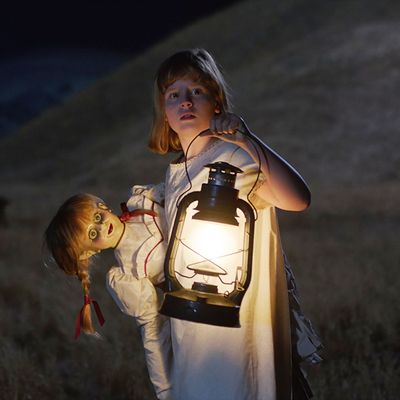
Something you see come up a lot in criticism is praise of stories that “take their time.” Typically, this feels right: In film and TV, the longer a story lets us get to know the characters we’re supposed to be invested in and stew in escalating drama or tension, the logic goes, the more we appreciate when it finally breaks. We also value stories that honor our intelligence, that believe we might have an attention span longer than a hummingbird’s. There is a certain modern fetishization of slowness, borne out of the same impulse that is certain steel-cut oats taste better and tells us every couple years that we really should write more letters. Slowness equals intelligence, and few genres bear the weight of that assumption more than horror.
Annabelle: Creation is one hour and 49 minutes long. That’s just over ten minutes shy of the run time of The Exorcist, another film that deals with demons and holy water and children in peril. That’s not as unfair of a comparison as it may sound: director David F. Sandberg, of last year’s Lights Out, possesses technical skills that are nothing to sniff at, and this mid-century period piece feels richly detailed and lovingly filmed. The dusty old country house where the majority of the film’s action takes place feels like as much of a real, time-worn place as it does a soon-to-be terror trap. But whereas Exorcist director William Friedkin never stopped building a holistic, inescapable sense of dread whether or not someone’s head was twisting around backward, Annabelle: Creation’s countless sequences of foreboding silence — hands reaching for doorknobs, our heroines shuddering in the dark, waiting for their demonic tormentor to attack — offer nothing to really latch on to, no larger reason to care that’s not purely technical. It’s proof that slower doesn’t always mean better in horror.
Not having seen the original Annabelle shouldn’t affect your appreciation of this origin story. The film opens with a lovely, only subtly disturbing wordless sequence in which artisan Samuel Mullins (Anthony LaPaglia) assembles the titular doll in his workshop. Shortly afterward, in a few quick strokes we meet his happy family unit: wife Esther (Miranda Otto) and daughter Bee (Samara Lee). All of it is lost, though, when Bee is hit by a car and dies. Fast forward 12 years, when we learn that the tragic Mullinses have opened their doors to a small group of girls from an orphanage. During a tour of the house, the new guests are given strict instructions never to enter a certain bedroom of a certain little dead girl. Of course, kindhearted polio survivor Janice (Talitha Bateman) is overcome by curiosity and goes in anyway, and soon meets the totally normal, definitely harmless doll that lives there.
A caveat: While this is not my first review of a horror movie, it’s the first where I feel it’s relevant to bring up my inability to be frightened by the vast majority of ostensibly scary films. (It’s more of a disadvantage than you’d think!) This doesn’t affect my enjoyment of films that are a campy good time (Wish Upon) or have something political or social at work under the hood (Get Out), but for films like Annabelle: Creation, whose sole purpose is to give you the spooks, it’s sounding a dog whistle I just can’t hear.
Taking that into consideration, I found Sandberg’s most successful scary flourishes to be the ones that utilized the uncanny scale of the titular doll. Seeing her rise up, out-of-focus, behind Janice’s back was one of the better chills, as well as a jump scare in a darkened space under some stairs that is just kinetically unexpected enough to knock the wind out of you. The cast is mostly anchored by child actors, and the two young leads are both fantastic horror surrogates, especially the plucky Linda (Lulu Wilson) who has a great sequence with a toy bazooka that is both funny and nightmarish.
But once the actual demons take over, this scare-deaf critic could no longer take any of it seriously, and the film’s multiple threads of different girls getting scared in different rooms in the house started to feel rhythmically unfocused — to the degree that I was checking my watch even as a principle character was crucified to the wall in gory detail. There’s nothing cheap about the rest of Annabelle: Creation, so this scattered finale felt like a letdown. But again, your mileage may vary; one person’s haunted doll horror is another person’s clown horror is another person’s creeping specter of postnuclear toxic masculinity horror. At least haunted dolls aren’t real!

